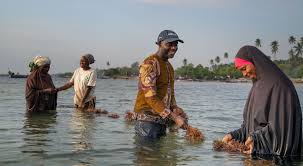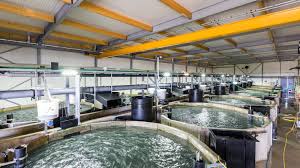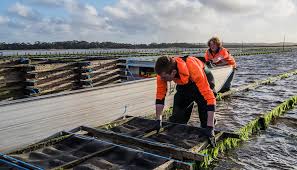Aquaculture is a distinct commercial activity that has provided an excellent response to the global demand for fish and seafood through a nutritious and affordable source of animal protein.
The technique facilitates the domestication of fish while guaranteeing optimum fish health and high-quality fish products through good feeding, care of cultivated fish, and sustainable harvests of various fish types.
Read Also: The Guava Peduncle: Economic Importance, Uses, and By-Products
Objectives of Aquaculture

- To increase fish production and consequently protein intake.
- To stock waters depleted through pollution, over-fishing, and high predation of offspring.
- For the production of fishing baits for the commercial and industrial fisheries sectors.
- For ornamental fish production to increase fish species populations for aesthetic purposes.
- For large-scale production of miscellaneous fish species for industrial purposes, such as fish meal and fish flour.
Aquaculture (Aquafarming) as a Fisheries Technique

Aquaculture refers to the cultivation of natural water produce, such as fish, shellfish, algae, and other aquatic organisms, in either freshwater or saltwater. It differs from fishing in that it involves active human effort to maintain or increase the number of organisms, rather than simply harvesting them from the wild.
Economically, aquaculture covers practices like broodstock maturation, larval rearing, fingerling production, research animal production, specific pathogen-free (SPF) animal production, as well as caviar and ornamental fish production.
Aquaculture methods include:
i. Mariculture (aquaculture in the ocean)
ii. Algaculture (production of kelp, seaweed, and other algae)
iii. Fish farming (raising catfish, tilapia, and milkfish in freshwater or brackish ponds, and salmon in marine ponds)
iv. Cultured pearls (growing pearls from oysters)
In 2003, aquaculture accounted for about 31% of the total global production of fisheries products. The growth rate of aquaculture is rapid, exceeding 10% per year for many species, compared to the flat contribution of wild fisheries.
Aquaculture minimizes environmental damage from fishing through the use of a recirculating aquaculture system (RAS), which involves culture tanks and filters where water is continuously recycled.
Water is treated mechanically to remove particulate matter and biologically to convert harmful chemicals into non-toxic forms, preventing the deterioration of water quality. Optimal water quality is maintained through UV sterilization, ozonation, and oxygen injection, which improve feed utilization and fish growth.
Aquaculture also reduces escaped fish, water usage, and the introduction of harmful pollutants. One drawback is the need for water exchange, which can be addressed by aquaponics (incorporating hydroponically grown plants) and denitrification.
Read Also: The Guava Leaves: Economic Importance, Uses, and By-Products
Types of Aquaculture

Aquaculture can be categorized as intensive, semi-intensive, or extensive, depending on the level of inputs applied, such as liming, fertilization, stocking, and management. It may involve monoculture (stocking a single species of fish in a pond) or polyculture (culturing multiple species of fish in a pond).
Criteria for selecting fish species include local availability, ability to live and breed in confinement, efficient conversion of food to flesh, resistance to parasites and diseases, and high market value.
Fish species in aquaculture include:
- Tilapia (e.g., Tilapia zilli, Oreochromis niloticus)
- Cod, Trout (e.g., Rainbow trout)
- Atlantic salmon, Catfish (e.g., Cyrysichthys nigrodigitans)
- Mud catfish (e.g., Clarias gariepinus, Heterobranchus bidorsalis)
- Moonfish (Citharius citharius), African bony tongue (Heterotis niloticus)
- Nile perch (Lates niloticus), Snakehead (Chana obscura)
- Mormyrid (Gymnarchus niloticus), Milkfish, Common carp, and Mudfish
Intensive (Closed-Circulation) Aquaculture
This involves the use of a network of circulation systems for fish cultivation.
1. Extensive (Pond) Aquaculture
Fish are fed naturally by zooplankton feeding on pelagic algae or benthic animals such as crustaceans and mollusks, though food sources are limited.
- Specific Types within Intensive and Extensive Aquaculture Include:
- Integrated recycling systems involving large plastic fish tanks in a greenhouse with hydroponic beds nearby or between the tanks.
- Irrigation ditch or pond systems using farm ponds or irrigation ditches for raising fish.
- Cage systems raising fish in synthetic cages placed in rivers, lakes, or filled quarries.
- Classic fry farming using fry or fingerlings to raise trout or other sport fish.
Aquaculture involves the cultivation of fish in freshwater or saltwater, not only for maintaining or increasing fish populations but also to minimize environmental damage and ensure optimal water quality. Various techniques, including extensive, semi-intensive, and intensive systems, are used for this purpose.
Do you have any questions, suggestions, or contributions? If so, please feel free to use the comment box below to share your thoughts. We also encourage you to kindly share this information with others who might benefit from it. Since we can’t reach everyone at once, we truly appreciate your help in spreading the word. Thank you so much for your support and for sharing!
Frequently Asked Questions
We will update this section soon.

